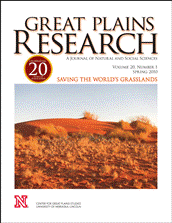Center for Great Plains Studies

Great Plains Research: A Journal of Natural and Social Sciences (through 2013)
Date of this Version
Spring 1999
Document Type
Article
Abstract
Low-density development consumes large tracts of the rural landscape surrounding Great Plains cities. Our objective was to determine how low-density sprawl influences the presence of birds. We used logistic regression models developed for two eastern Great Plains study areas for 1966-1990 to determine the probability of occurrence of bird species on the same areas in 1902. The two areas experienced different levels of low-density urban sprawl from 1902-1990. Birds associated with forests and forest edge are expected to decrease in both areas. Some of these are species of high concern. Dickcissel, a grassland bird, is expected to increase in the area of low sprawl, whereas several bird species associated with intense development, such as the house sparrow, are expected to increase in the area with a greater level of urban sprawl. We conclude that changes in land use and human activity associated with urbanization are influencing plains bird communities.


Comments
Published in Great Plains Research 9 (Spring 1999): 55-73. Copyright © 1999 The Center for Great Plains Studies, University of Nebraska–Lincoln. Used by permission. http://www.unl.edu/plains/publications/GPR/gpr.shtml